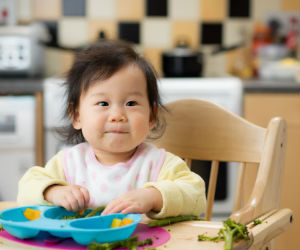Starting solids with your baby can be both exciting and overwhelming. Let me take some of the confusion out the process, so it’s more exciting and rewarding for you and baby. Let’s chat about when, what, and how to serve up your baby’s first foods.
When to start feeding
When your little one is ready to begin eating solid foods, he or she will display a few telltale signs. As exciting and fun as this journey can be, remember that it’s important to have all the signs of readiness present before baby’s first bite. Here’s what to watch for:
Baby is sitting up independently or able to sit up with little assistance in a high chair: When a babies eat, it is very important that they have neck control. This has to do with their ability to swallow properly. When it’s time for eating, babies need to be upright, never laying down or reclined. Ignore the pictures of babies reclined in bouncy chairs and eating from a spoon, please—this is not recommended.
Baby is showing interest in your food: Is your baby reaching for what you are eating? Are they making noises and showing excitement or enthusiasm to eat or try what you are eating? If so, you can check this box off.
Baby is putting toys to their mouth: Is your baby beginning to grab toys and put them to their mouth to gum the toys? This is a skill set that helps baby begin the self-feeding process.
These are the current feeding recommendations as set forth by the American Academy of Pediatrics. Watching for signs of readiness will help you and your baby have a good experience when starting the feeding journey. If your baby is not showing interest, don’t fret. Instead, try again the next meal or day. Keep the feeding process as stress-free as possible, because your baby is picking up your cues. When in doubt be sure to review this article, Is baby ready to start solids?
How to start the feeding journey
The most common question I get about how to start the feeding journey is, “Do I need to feed one food at a time?” The answer is, “It depends.” Does your family have an allergy risk? If the answer is no then start off with 1-3 foods the first day. If you notice signs of an allergic reaction (vomiting, rash, or diarrhea) then stop with these foods and contact your pediatrician. If your baby doesn’t show any reaction to the food, which is most common, then try new foods the next day.
If your family has a history of allergies, be sure to consult your pediatrician. Your child’s doctor may encourage you to try high-allergen foods first, one at a time for four days to see if there is a reaction.
Note, your baby will only be eating about a tablespoon of food to start. Babies tummies are small and can only hold so much food. Their digestive systems are just beginning to process foods, so give them time and expect a little gas in the beginning. The goal is to try 100 new foods within baby first year of life. As for how to feed your baby you can either choose a traditional spoon-feeding method or opt for a baby-led weaning approach.
Top 5 foods
From a nutrition stance, I highly recommend kicking off the journey pinpointing foods which are high in iron, vitamin C (which helps iron absorption), and fats. It is also recommended to tackle those high allergen foods (nuts, shellfish, dairy, soy, wheat, and corn) within the first month or two of eating. Think of this list as something fatty, something meaty or rich in iron, and something colorful.
- Avocado: High in fat, this fruit makes for a tasty first food.
- Beef or lamb: Take your pick, both are high in iron and an excellent first food either as steak fingers or pureed.
- Sweet Potatoes: Loaded with vitamins A and C, sweet potatoes are delicious and easy to roast or steam before serving.
- Full Fat plain yogurt: Before jumping to the next line, be sure to test plain yogurt on baby first. Just place a baby-friendly spoon on their tray and let them self feed (or make a mess). An excellent source of probiotics, calcium, and essential fats, yogurt is a nifty way to stack nutrition and mix in other fun things like nut butters or grated vegetables. Try using carrots and zucchini (use the finest grating setting you can, similar to a microplane).
- Full-fat plain yogurt with a teaspoon of peanut butter: Both dairy and nuts are high allergy-risk foods, so knocking them out early on is a good thing. Serving up plain nuts or a spoonful of nut butter is a serious choking hazard. Instead, I recommend adding nut butters into sauces or stirring them into yogurt to thin and make for a safe texture.
- Eggs: Loaded with vitamin D, iron, choline, and essential fats, eggs are an excellent first food. Mashing up boiled eggs with an avocado makes for a healthy egg salad and a nutrient-dense first food.
There’s no need for making a special meal just for your baby. If these foods are not on your table now, perhaps consider beefing up your menu and enjoying these foods with your baby. Feeding baby can challenge us to improve our own diets. Remember, our little ones learn from watching us, so show them how much you enjoy eating a variety of healthful foods with them!
